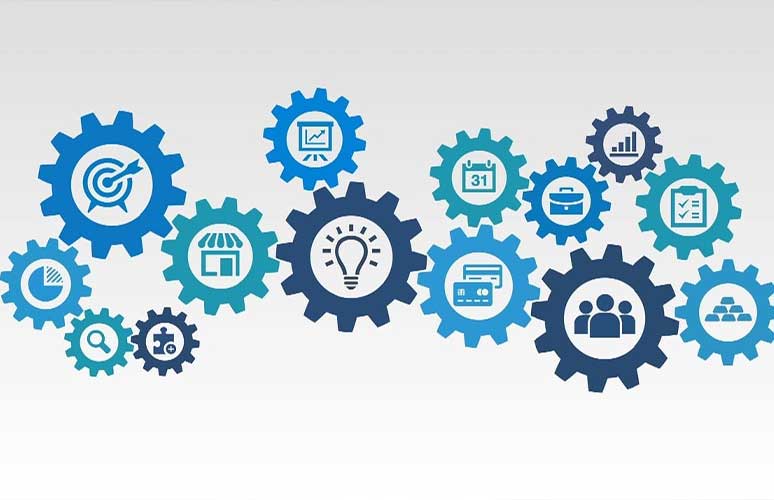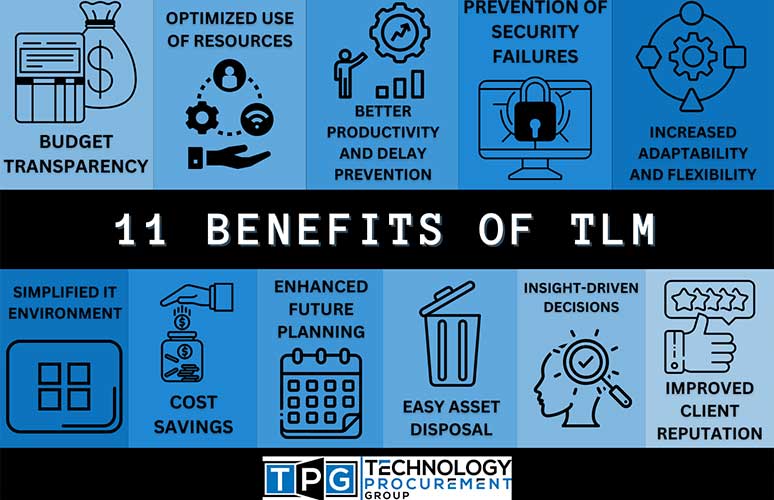As businesses’ use of various technologies grows and the tech lifecycle becomes shorter, it’s more crucial than ever to engage in technology lifecycle management, or TLM. Read on to learn more about what TLM is, how your organization can benefit from it, what can happen if you don’t use it, and the best practices you should follow.
Table of Contents
What Is Technology Lifecycle Management (TLM)?

Technology lifecycle management, abbreviated as TLM, is a strategic, multi-phased approach that seeks to simplify and optimize an organization’s IT environment.
It includes:
- The research, planning, and design needed for technology purchases
- The acquisition and implementation of IT assets
- The management of IT assets
- The decline and retirement of IT assets
TLM brings technical knowledge, business processes, engineering, and financial services into a cohesive business model. It allows organizations to proactively and systematically address their IT infrastructure budget and long-term management so that businesses can make the correct purchasing decisions and manage their technology investments wisely.
Although businesses (particularly small ones) can conduct this process independently, TLM usually involves partnering with a consultant or provider who then manages every aspect of IT and telecom technology.
Why Does Your Business Need TLM?
The need for technology lifecycle management has skyrocketed recently, mainly due to digital transformation pushing businesses’ IT to the cloud, as well as the growing use of the Internet of Things (IoT) and mobile technology. Organizations now have more IT assets and devices to track and maintain than ever before.
How Does TLM Differ for Large and Small Organizations?

While TLM’s principles are largely the same regardless of an organization’s size, its complexity grows with the size of the company. Businesses in the technology sector will also experience increased complexity. This is because, in some cases, trademarks and patents will be involved. There may even be a need for innovative methodology.
TLM will generally be simpler for most small and midsize businesses that aren’t in the tech sector, but the process is just as important for them as it is for larger enterprises.
What Are the Basic Elements of TLM?
Technology lifecycle management includes several basic elements.
- A detailed inventory of every technology asset, including cloud platforms, applications, operating systems, hardware, middleware, and dependencies between elements
- The assignment of an asset owner and business process for each asset
- A highly detailed schedule that includes updates and reviews for each asset
- A record of expiration dates, lead times, and provider roadmaps that explains when resources may become obsolete or no longer be supported and when replacement should be planned
Phases of Technology Lifecycle Management
The elements of TLM discussed above are often separated into the six phases below.

Phase 1: Assessment
The beginning of the TLM process involves assessment. This is a proactive stage in which your business looks at its current needs and its future plans for growth, as well as its goals for technology and how that technology must support its business objectives.
Your organization may produce a comprehensive report for technical and business stakeholders during this phase. The report might weigh the benefits of using in-house IT services against the advantages of outsourcing technology lifecycle management to a provider or as a service (aaS) options. You might choose a TLM provider during this phase, or you may decide to conduct TLM in-house.
Phase 2: Acquisition
During the second phase, it’s time to execute the objectives detailed in Phase 1. As part of acquisition, your organization procures technology assets, determines the logistics of each purchase, and finalizes acquisition financing.
Phase 3: Implementation

Phase 3 involves the implementation and management of the acquired technology. The assets must be deployed and integrated into the IT environment, and they’ll also need to be tracked, with each asset having an identified owner and purpose.
Phase 4: Support
Phase 4 is support, a highly valuable element that will be ongoing throughout the entire TLM process. Support provided by a TLM consultant will be comprehensive, optimizing the performance of the entire IT environment. Your provider will proactively monitor for incidents, conduct periodic reviews of performance metrics, evaluate product warranty extensions, and more.
Phrase 5: Optimization
The fifth phase of TLM is a critical step in which some assets may be refreshed or replaced. Phase 5 usually happens in cycles that may range from every two to every five years.
The goal is to optimize the devices and system components to support your organization’s objectives and drive business strategies. Another important part of this phase is ensuring sufficient funds are set aside for future technology requirements.
Phase 6: Disposal

The final phase of TLM (before the process essentially repeats) is asset disposal. The initial report from Phase 1 should include a plan for asset disposal which will be followed at this point. Your TLM provider will take care of reselling, recycling, or disposing of IT assets. They will also manage any concerns around the environmental impact of retiring technology.
Benefits of Technology Lifecycle Management
There are numerous benefits to technology lifecycle management. Many are focused on avoiding unanticipated costs, preventing process failures, and taking advantage of any technology-related opportunities that present themselves.

Budget Transparency
One advantage of TLM is having more transparency into your organization’s IT budget. This can also translate into better control over IT spending since all items will be on a single invoice. It’ll no longer be necessary to look through multiple invoices or hundreds of line items when seeking to adjust a single aspect of the budget.
Optimized Use of Resources
Technology lifecycle management enables you to properly allocate the business’s resources. You’ll be able to put them into growth and business enhancement rather than being forced to spend them on recovery.
Cost Savings

Of course, a huge benefit of TLM is cost savings. If you can bundle your IT assets with one provider, you may cut back on service and subscription costs by 20% or more.
Meanwhile, since your technology upgrades will be planned ahead, there will be no unexpected expenses or shocking invoices. You’ll enjoy better budgeting through clear, deliberate planning for future expenditures, which can help owners, CFOs, and others involved in purchases make informed decisions that consider the IT system.
In addition, TLM providers typically have close business relationships with technology providers and can help you negotiate telecom contacts for the best pricing possible, resulting in additional cost savings.
Simplified IT Environment
In general, TLM streamlines the IT environment. It allows you to manage a single contract and monthly invoice by bundling your assets so that you can handle everything from one location.
Better Productivity and Delay Prevention
Another fantastic upside to TLM that can even increase your revenue is better productivity and delay prevention. With higher uptime rates, up-to-date infrastructure, and the latest software solutions, your organization will experience fewer service interruptions, leading to better productivity and stronger business processes.
If issues do arise, support services can get you back to work quickly–all you need to do is make a single phone call to your TLM consultant.
You probably already know how damaging it can be when IT infrastructure fails. Employees may be unable to access necessary information, customers may begin to complain, and your business may even lose revenue, particularly when problems occur in the middle of a busy workday.
Sadly, it’s common for IT infrastructure to fail because it has simply reached the end of its lifecycle. This is completely avoidable, and TLM can prevent it. But even if technology doesn’t fail completely, it can cost your business money in other ways: crashing software, slow networks, and time-consuming workarounds are just a few examples. TLM ensures that employees have the fully functional technology they need to complete their jobs and do them well.
Enhanced Future Planning
One of the main points of technology lifecycle management is to develop strategies that anticipate system requirements and plan for the future. TLM helps companies focus on their business goals and performance objectives by leveraging their technological resources. It ensures that your organization has plenty of time to make fully informed purchasing decisions before technology fails and you’re forced to make a quick choice without considering all of the pros and cons.
Easy Asset Disposal
You’re likely already aware that technology becomes obsolete extremely quickly. A TLM provider can make sure that asset disposal is quick and painless. They’ll handle all the aspects of disposal, such as e-recycling and managing the data security of retired devices.
Insight-Driven Decisions

Many organizations tend to miscalculate technology’s cost of ownership, leading them to make poorly-informed purchasing decisions. TLM provides insight into the total cost of ownership for each technology asset, including maintenance and repairs, which contributes to well-informed decisions.
Prevention of Security Failures
Unfortunately, old networks, out-of-date software, and outdated systems are all common targets for hackers and malware. It’s easy to exploit their vulnerabilities. Attacks can potentially result in lost data, damaged customer relations (if the security breach affects user data), and even legal consequences in cases where the breach causes your organization to fail compliance regulations.
With TLM, you can ensure that your networks are always up-to-date, protecting from cybersecurity threats and PR problems. By replacing technology before it becomes outdated, your organization can easily avoid breaches and failures that could threaten its reputation and revenue.
Improved Client Reputation
As mentioned above, security failures (which often occur due to outdated technology) can damage your reputation among clients. But with fully optimized tech, you’re far less likely to experience the glitches, downtime, and security risks that can lead to frustration and inconvenience for your clients. Instead, you’ll be far more consistent and reliable, contributing to an improved reputation.
Increased Adaptability and Flexibility
One of TLM’s main functions is planning for the future, which can make your organization more flexible and adaptable. Having a clear view of your current state and what is ahead can help you respond to opportunities appropriately and take advantage of full freedom of choice when it comes to your next steps.
What Happens If You Don’t Use TLM?

We’ve talked about TLM’s benefits, but now, let’s discuss what you can expect to happen if you choose not to invest in technology lifecycle management.
Unanticipated Costs
A downside of not using TLM is that you’re much more likely to run into unanticipated costs, usually due to technology failure. Replacing failed technology when you haven’t planned to do so is often time-consuming and expensive. You may not have the necessary time to look into all the available options and negotiate pricing. Instead, you’ll likely have to make a snap decision to ensure you have functional technology again as soon as possible.
Going into crisis mode when tech unexpectedly fails often comes with costs that wouldn’t negatively impact the business if they’d simply been planned for or if the crisis had been prevented altogether with the use of TLM.
Missed Opportunities
When your applications are missing the latest features, your technology hasn’t been updated, and you have security gaps in your IT environment, you’re likely to lose the flexibility and adaptability that can enable you to take on new opportunities.
Without TLM, it’s possible you’ll miss out on a variety of potentially beneficial opportunities, such as special pricing through bundling, savings that could have been achieved through negotiation, and chances to build advantageous partnerships with technology suppliers.
Failed Business Processes
One of the worst potential impacts of not having TLM can be failed business processes. Often, these stem from security breaches and technology dysfunction, which, in turn, stem from outdated technology.
Failed business processes are often distracting and stressful for employees and stakeholders alike. Those who are part of the organization are typically forced to focus on recovery above all else, which can then harm the business’s revenue and overall reputation.
Loss of Customers and Revenue

The business’s revenue and reputation can be harmed when TLM isn’t used. You might think about it this way: When your system is down for hours or even days, how does that affect your revenue? Similarly, if a valuable feature is no longer supported and suddenly not available for customers anymore, how will they respond?
More Complex IT Environment
The simplification of the IT environment is one of TLM’s most notable benefits. You can generally expect to experience a more complex IT environment without technology lifecycle management. You’ll likely have numerous invoices to handle, won’t be aware of when technology needs to be updated and replaced, and will be forced to handle stressful situations that put you into crisis mode more often.
Technology Lifecycle Management Best Practices

Here are a few best practices to remember for technology lifecycle management.
Focus on the Future
A core tenet of TLM is thinking about the future, not just the present moment. You want to optimize today’s technology while planning for tomorrow’s needs and goals.
Create a Long-Term Plan
It’s best to create a long-term plan for TLM, as the timing of when and how you invest in new technology is often just as important as the assets you purchase. Replacing old technology at the right time can result in the avoidance of security breaches, preventing hassles. Plus, having time to fully evaluate and negotiate your purchases means you’ll save money and make better decisions.
Protect Your Investments

The biggest threat to your business data is cybersecurity issues. Defending your investments by ensuring that your technology lifecycle management plan includes sufficient protection for your entire technology environment is vital.
Conduct Cost-Benefit Analyses
To get the most out of TLM, complete cost-benefit analyses before making purchasing decisions. Rather than simply buying all of the latest technological advancements, do the research necessary to learn whether or not each tool will provide tangible benefits to your organization. A cost-benefit analysis should include an evaluation of the total cost of ownership, including the purchase price, labor, maintenance, and support, and a comparison of this cost to the total benefit the purchase will bring to your company.
TPG Can Help You Make Informed Purchasing Decisions

Technology Procurement Group can help you optimize your procurement process for telecom and IT, ensuring you make purchasing decisions that facilitate business objectives while working to ensure low pricing and agreeable contract terms.
We offer IT procurement services, telecom procurement strategy consulting, telecom contract negotiation service, and RFP management, as well as wireless expense reduction and TEM and WEM procurement.
For more information, call us at 1-888-449-1580, email us at info@TPG-llc.com, or complete the form on the Contact Us page. We look forward to working with you!



